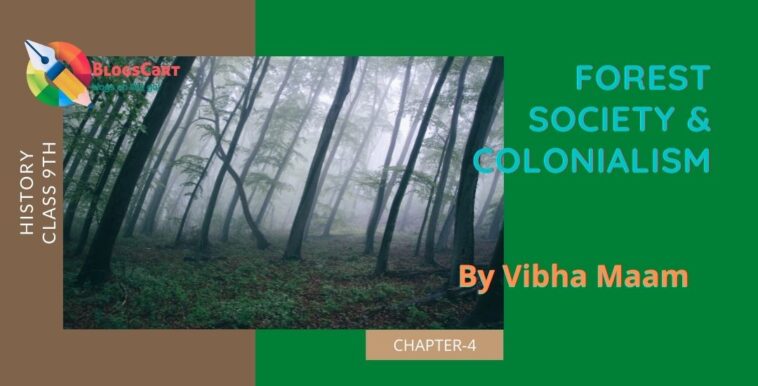Share this handpicked notes of NCERT class 9th History Chapter 4 Forest Society and Colonialism notes by Vibha Madam to your friends and classmates.
Forest Society and Colonialism notes by Vibha Mam
Importance of Forests
Forests provide us with so many things like paper, wood, timber, dyes, spices, tendu leaf in bidis, gum, honey, coffee, tea and rubber.
Forests also provide bamboo, wood for fuel, grass, charcoal, packaging, fruits, flowers, animals, birds and many other things.
We also get medicinal plants from forests. So, many herbs and plant roots are used for medicinal purposes.
There are so many varieties and different plant species found in our forest patch.
A lot of this diversity is fast disappearing between 1700 and 1995.
The causes of Deforestation during the colonial period
- Unproductive and virgin vegetation
- Shipbuilding
- Introduction of railways
- Need for sleepers and fuels
- Industrialisation
- Agricultural expansion
- Plantation
- Adivasis in other peasants users.
The Rise of Commercial Forestry
- The British needed Forests in order to build ships and railways.
- The British government took some steps to conserve forest from the local people and traders.
- Dietrich Brandis was appointed as the first inspector general of forest in India.
- He formulated rules to use the forests and train the people in the science of conservation.
- He introduced the Scientific forestry.
- He set up the Indian forest service in 1864 and formulated the Indian forest act in 1865.
- The imperial Forest Research Institute (FRI) was set up at Dehradun in 1906.
What was Scientific Forestry?
Scientific forestry was one of the methods of forest management, under which different types of natural trees were cut down and in their place one type of trees was planted in straight rows.
They planned how much area of the forest to cut every year and then cut area was then to be replanted for the further.
Importance of Forests for the forest communities
- Villagers are dependent on forests for their fuel, fodder and leaves.
- Their livelihood is totally dependent on the forests.
- People use forest products like fruits, roots, timber.
- Herbs are used for medicines, wood for agricultural implements.
- Vegetable oil can be made by mahua fruits.
- The bark of the Semur tree is used to grate vegetables.
- They use leaves for making disposable plates and cups.
- The forest act created severe hardship for villagers across the country.
- After the act, all their everyday practices become illegal.
Shifting agriculture or Swidden agriculture is practiced in many parts of Asia, Africa and South America. The government decided to ban shifting cultivation as it is considered as harmful practice.
Many communities were forcibly displaced from their homes. They had to change the occupation while some resisted through large and small rebellions.
Local names of Shifting Agriculture or Swidden agriculture
India:- Dhya, Penda, Bewar, Nevada, Podu, Jhum, Kumri and Khandad
Southeast Asia:- Lading
Central America:- Milpa
Africa:- Chitmene, Tavy
Sri lanka:- Chena
New traders, New Employments and New Services
Many communities left their traditional occupation and started trading in forest products.
The Mundurucu people( Brazilian) who cultivated manioc, began to collect latex from wild rubber trees.
Many adivasi communities started trading elephants and other goods like hides, horns, silk cocoons, ivory, bamboo, spices fibers, gums and resins.
Many workers were recruited to work on tea plantations.
Rebellion in the Forest
In many part of India, forest communities rebelled against the forest Act by British government.
The leaders of these movements against the British like Siddhu and Kanu in the Santhal pargana, Birsa Munda of Chhota Nagpur and Alluri Sitarama Raju of Andhra Pradesh are still remembered.
Rebel in Bastar
- Bastar is located in the southernmost part of Chhattisgarh.
- A number of different communities live in Bastar like Maria, Muria, Gond, Dhurwas, Halbas and Batras.
- The colonial government proposed to reserve two-thirds of the forest in 1905.
- The people of Bastar were very worried that some villages were allowed to stay on in the Reserve Forest as ‘ forest village’ on the condition. They worked for the forest department for free.
- People of other villages were displaced .
- For long, villagers had been suffering from increased land rent and free labour for colonial officials. Villagers gettered to rebel against the British.
- The initiative was taken by the Dhurwas of the kanger forest.
- Gunda Dhur was the leader of his movement.
- The British sent troops to suppress the rebellion, however they never managed to capture Gunda Dhur. In a major victory for the rebels, work on reservation was temporarily suspended.
Forest transformation in Java
- Java is a famous rice- producing Island in Indonesia. The Dutch started forest management in Java.
- Kalangs was a tribal community of Java. They were skilled forest cutters and practiced shifting cultivation.
- They had great skill in harvesting teak and building palaces.
- When the Dutch began to gain control over the forest in the eighteenth century the Kalangs resisted but the uprising was suppressed by the Dutch.
Blandongdiensten System
- Under this system, the Dutch exempted some villages from the rent on land if they worked collectively to provide free labour and buffaloes for cutting and transporting timber.
- Later, instead of rent exemption, forest villages were given small wages but their right to cultivate forest land was restricted.
Samin’s Challenge
- Surontiko Samin was the leader of the Samin’s movement. He argued for ownership of the forests.
- By 1907, some of the Saminists protected by laying down on their land when the Dutch came to survey while others refused to pay taxes or perform labour.
Don’t forget to comment in the comment section below to appreciate the hard work of our author by sharing this notes with your known person you can also Contact us for any query or if you are interested in writing with us.
Stay tuned for more amazing stories, poems & articles like this.











Fantastic job mam
lucid explanation maam
great notes